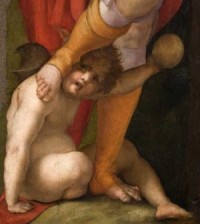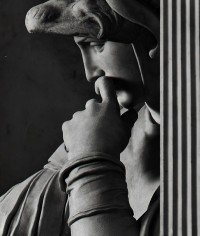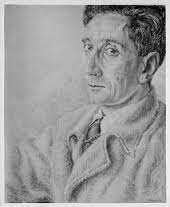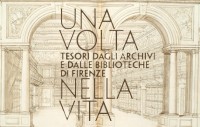By Giulia Bagni (University of Florence)
Until the 2nd of March, it is possible to visit in Pontorme (Empoli), a small exhibit dedicated to the legacy that Pontormo left to the painters that work within the territory of Empoli. The place was not chosen casually, because it is the birthplace of Jacopo Pontormo. It is a presupposition exhibit for the exhibit opening at the Palazzo Strozzi in March, focused on this artist and Rosso Fiorentino.
The exhibit is divided into two places: part is in the house of Jacopo and the Chiesa di San Michele with the adjacent dedicated fellowship.
In the first part, one can see that the house was restored recently and it is possible to admire the two drawings by Pontormo that are on loan from the Gabinetto dei disegni e della stampe degli Uffizi. As well as a replica of the Madonna del Libro, which is on permanent loan to the house of the artist from the Uffizi. The drawings are placed in a case with good lighting and proper inclination in order to see the drawings well without reflections.
Continuing along the same street as the house, one arrives at the Compagnia di San Michele where there are paintings by artists influenced by Pontormo, including Bronzino, Jacopo da Empoli, and Cigoli.
Finally, within the church one finds, among other things, the San Giovanni Evangelista and the San MicheleArcangelo which were made by Pontormo, which the exhibit revolves around.
The main purpose of this exhibit, as well as the others that are organized by Città degli Uffizi is to give value to the artists which are less known by the public by bringing them back to the places that they were produced in. The Città degli Uffizi also wants to give value to works of art that are still present in their original territories by trying to recreate the context in which they were born in and to explain the consequences that the works had on other artists. Notwithstanding the intentions of the Città degli Uffizi, these exhibitions show criticality, starting with advertisements, which are totally absent except for the territory of Empoli.
The exhibit pathway is not clear, even in the brochure, however there is a point where the exhibit begins and where the exhibit ends, because you must first begin at the house of Pontormo in order to purchase the ticket.
As I said, this is presupposition to the exhibit of Palazzo Strozzi that will be more expansive and articulate, but the fact that this is a presupposition does not justify the lack of important elements such as text panels. This absence prevents the visitors understanding the proper place of the art works by Pontormo in Florentine 16thcentury. This renders it difficult for a visitor with no experience to make the right connections between the work of Pontormo and his disciples.
The works within the exhibit are provided with concise labels, which do not give useful information to the visitors who approach this subject for the first time. Further, the texts are only in Italian, which impedes the access of tourists.
Only after purchasing the catalog and reading the essays one can really understand the meaning of the exhibition and make connections between the paintings.
On a positive note, the exhibition ticket for the duration of the exhibit allows to visit two other museums for a reduced price in Empoli: the Museum of Glass and the Museo della Collegiata di Sant’ Andrea. In the Museo della Collegiata there are important works by Andrea della Robbia, Francesco Botticini, and Lorenzo Monaco. This is a good expedient to convince people to visit these two important institutions.
For more information, visit the website: http://www.lacittadegliuffizi.org/index.php/mostre/pontormo-e-il-suo-seguito-nelle-terre-dempoli/
Pontormo e il suo seguito nelle terre di Empoli
Giulia Bagni (Università di Firenze)
Fino al 2 marzo è possibile visitare a Pontorme (Empoli), una piccola mostra dedicata “agli esiti che l’ascendente pontormesco sortì nelle creazioni di pittori attivi nell’empolese”. Il luogo, scelto non casualmente, è proprio il paese natale di Jacopo Pontormo. Questa vuole essere una premessa alla mostra che si terrà a Palazzo Strozzi a partire da marzo, incentrata proprio su questo artista e Rosso Fiorentino.
La mostra si divide in due sedi: la casa di Jacopo e la Chiesa di S. Michele con l’annessa compagnia.
Nella prima, oltre alla casa restaurata recentemente, è possibile ammirare due disegni del Pontormo provenienti dal Gabinetto dei disegni e delle stampe degli Uffizi, e una replica della notissima Madonna del Libro, che è in deposito permanente presso la casa dell’artista e proviene anch’essa dagli Uffizi. I disegni sono disposti in una teca e grazie ad una buona illuminazione e ad una giusta inclinazione sono perfettamente visibili in ogni minimo particolare, senza fastidiosi riflessi.
Procedendo sulla stessa via dove si trova la casa, si arriva anche alla Compagnia di S. Michele, dove sono presenti opere pittoriche di artisti influenzati dal Pontormo, come Bronzino, Jacopo da Empoli e il Cigoli.
Infine nella Chiesa si trova, fra le altre cose, la pala con S. Giovanni Evangelista e S. Michele Arcangelo del nostro pittore, fulcro attorno a cui ruota tutta l’esibizione.
Lo scopo principale di questa mostra, come del resto delle altre organizzate dalla Città degli Uffizi, è quello di valorizzare opere di artisti più o meno conosciuti a livello del grande pubblico, riportandole ai luoghi a cui appartennero, o valorizzare opere ancora presenti sul territorio, cercando di ricreare il contesto in cui nacquero e le conseguenze che ebbero in campo artistico, come in questo caso. Ma nonostante le intenzioni, l’esposizione presenta alcune criticità, a partire dalla pubblicità, totalmente assente, se non nelle zone circostanti Pontorme.
Anche il percorso d visita non è ben specificato, neppure nella brochure, anche se la prima tappa è costituta dalla casa del pittore poiché è solo qui che si può acquistare il biglietto.
Come ho detto all’inizio si tratta di una premessa alla rassegna ben più ampia e articolata che si terrà a Palazzo Strozzi, ma questo non giustifica la mancanza di elementi imprescindibili per la riuscita e l’efficacia di una buona esposizione, come i pannelli esplicativi. La loro assenza, in entrambe le sedi, impedisce di collocare l’opera del Pontormo all’interno del Cinquecento fiorentino, rendendo difficile, per un visitatore non esperto, stabilire collegamenti e connessioni tra le opere dell’artista e quelle dei suoi seguaci.
Le opere in mostra sono dotate solo di sintetiche didascalie che non forniscono informazioni utili ad un pubblico che si accosta per la prima volta ad un tema così importante. Inoltre i testi sono solo in italiano, impedendo di fatto l’accesso ai turisti stranieri.
Solo comprando il catalogo e leggendo i saggi e le relative schede delle opere si può veramente capire il senso di questa esposizione e stabilire delle connessioni, non solo iconografiche, tra i quadri presentati.
Una nota positiva è da riscontrare nel fatto che col biglietto della mostra, durante tutta la sua durata, è possibile accedere ad un prezzo ridotto a due musei di Empoli: il museo del Vetro e il museo della collegiata di S. Andrea, che contiene opere di Andrea della Robbia, Francesco Botticini e Lorenzo Monaco. Un valido accorgimento per far conoscere due importanti istituzioni presenti sul territorio.
Per ulteriori informazioni si veda il sito: http://www.lacittadegliuffizi.org/index.php/mostre/pontormo-e-il-suo-seguito-nelle-terre-dempoli/



